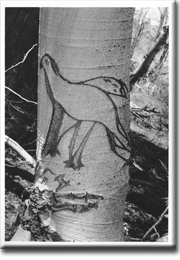BASQUE ASPEN ART OF THE SIERRA NEVADA
By Jean Moore Earl and Phillip I. Earl
Designed, Edited by Baobab Press
Basque translation by J. Mallea-Olaetxe
Grasp a unique look at a little-known aspect of immigrant culture in California and Nevada during the first half of the twentieth century from the artistry of Basque sheepherders who carved images on aspen trees in the Sierra Nevada Range.
Jean Moore Earl and Phillip I. Earl have spent forty years locating, identifying, and preserving these images, eventually assembling over 130 wax-on-muslin rubbings made directly from the carvings. This book reproduces a selection of those images and includes text describing the sheepherders’ world, the style and content of the carvings, and the Earls’ efforts to preserve them. Accompanying the text is a companion translation in the Basque language by noted Basque scholar Joxe Mallea-Olaetxe.
The years 1920 to 1950 were the high point of the sheep industry in the western U.S. The mountain meadows of the Sierra Nevada were an important source of summer forage, and Basque sheepherders, many recently arrived from the Pyrenees, were primarily responsible for tending the flocks.
The shepherd’s life among the aspen groves was isolated and solitary, and it led many herders to utilize the trees as a means of self-expression. Using simple tools such as pocket knives or nails, the herders turned to the white bark of the aspens. On this living canvas, they etched a remarkable series of carvings, recording everything from their own names to observations of the natural world around them, memories of the Basque Country, and not surprisingly, erotic fantasies. Over time, the living medium subtly altered the sheepherders’ work, and eventually doomed it. Most of the carvings are now lost except for in the pages of this book.
Book Details
Title: Basque Aspen Art of the Sierra Nevada
Author: Jean & Phillip Earl
Publication Date: March 2011
Size: 8″ x 9″ 140 pp., 275 illustrations (93 color and 24 b&w)
ISBN: 9781936097005
Trade Paper with Flaps
$32.95
Available at your favorite local bookstore or at Bookshop.org






